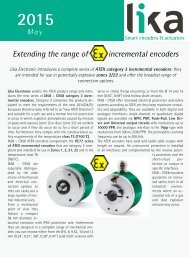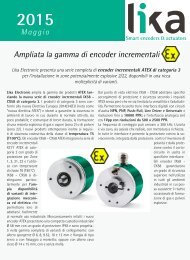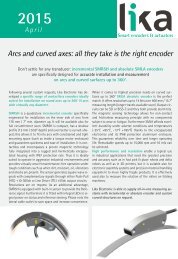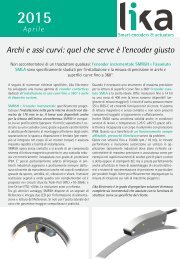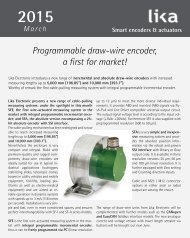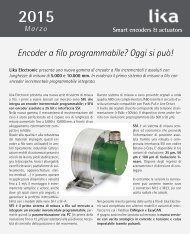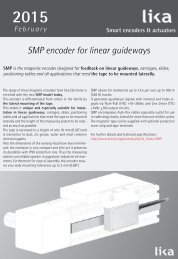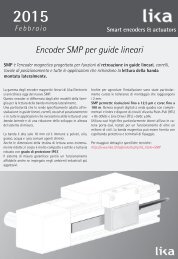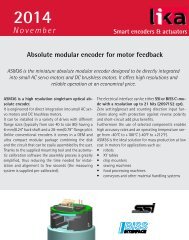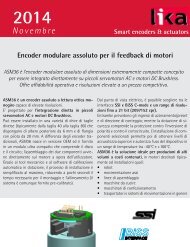LINEPULS & LINECOD catalogue 2016 in English
Lika Electronic incremental and absolute linear encoders catalogue 2016 in English Our new linear encoders catalogue is out now, and features many innovative new products and up-to-date information. The catalogue is expressly designed to set out the comprehensive range of incremental & absolute linear encoders from Lika Electronic. Check it out, it is completely renewed! Make sure you don’t miss out on a copy, download the pdf file from our web site or request your hard copy now! We have also got an interactive digital version in the works that shall be released soon!
Lika Electronic incremental and absolute linear encoders catalogue 2016 in English
Our new linear encoders catalogue is out now, and features many innovative new products and up-to-date information. The catalogue is expressly designed to set out the comprehensive range of incremental & absolute linear encoders from Lika Electronic. Check it out, it is completely renewed!
Make sure you don’t miss out on a copy, download the pdf file from our web site or request your hard copy now!
We have also got an interactive digital version in the works that shall be released soon!
You also want an ePaper? Increase the reach of your titles
YUMPU automatically turns print PDFs into web optimized ePapers that Google loves.
<strong>LINEPULS</strong><br />
Output signals<br />
SMEx1 l<strong>in</strong>ear encoders can be equipped with an additional PWM error output to signal fault<br />
and error conditions to a PLC or a controller. The electronics generates a pulse-width modulated<br />
(PWM) waveform signal with four different duty cycles. When the encoder falls <strong>in</strong>to<br />
error mode the diagnostic PWM signal is output. The duty cycle of the signal will depend on<br />
what caused the encoder to enter the error mode. A frequency error -that’s to say: when the<br />
encoder is travell<strong>in</strong>g too fast along the tape- will cause a 50% duty cycle to be generated.<br />
A distance error -i.e. when the specified mount<strong>in</strong>g tolerances are not met- will cause the<br />
diagnostic feedback signal to be at 75% duty cycle. Internal electronics error conditions will<br />
cause a 100% duty cycle to be generated, so the signal will be at high logic level solidly.<br />
On the contrary a low logic level (0% duty cycle) will <strong>in</strong>dicate that no error is active.<br />
PWM error output (on request)<br />
PWM error output characteristics<br />
Output signal<br />
Duty cycle D 0%<br />
LOW (0Vdc)<br />
Duty cycle D 50%<br />
Duty cycle D 75%<br />
Duty cycle D 100%<br />
HIGH (+Vdc)<br />
No error is active.<br />
Mean<strong>in</strong>g<br />
Frequency error: the sensor is<br />
travell<strong>in</strong>g too fast.<br />
Distance error: specified mount<strong>in</strong>g<br />
tolerances are not met.<br />
Internal error.<br />
The series available with PWM error output on demand are: SME11, SME21, SME51.<br />
The edge distance feature only applies to the<br />
<strong>in</strong>cremental digital signals and has to be selected<br />
under the option EDGE DISTANCE <strong>in</strong><br />
the order code. It can be def<strong>in</strong>ed as the m<strong>in</strong>imum<br />
spac<strong>in</strong>g time between two follow<strong>in</strong>g<br />
signal edges at output. The value is expressed<br />
<strong>in</strong> μsec and calculated referr<strong>in</strong>g to all edges.<br />
When choos<strong>in</strong>g the resolution of the encoder<br />
and its related m<strong>in</strong>imum edge distance, consider<br />
attentively also both the travel speed of<br />
the application and the max. frequency that<br />
the subsequent electronics is able to evaluate.<br />
Edge distance<br />
Unexpected situation with high travel speed to be considered are:<br />
• micro-vibrations;<br />
• heavy accelerations and decelerations.<br />
Signals will be output at the highest speed (see the edge distance value charts) when the<br />
sensor comes to a standstill exactly on a graduation mark, result<strong>in</strong>g <strong>in</strong> a frequent change of<br />
the output signal by +/- 1 <strong>in</strong>crement.<br />
Please note that the m<strong>in</strong>imum edge distance value is <strong>in</strong> relation with the max. speed value.<br />
For slower speeds the effective edge distance is necessarily greater.<br />
Also the max. mechanical travel speed <strong>in</strong>dicated <strong>in</strong> the datasheet has always to be considered<br />
attentively. It attests a mechanical permissible limit of the unit.<br />
27




